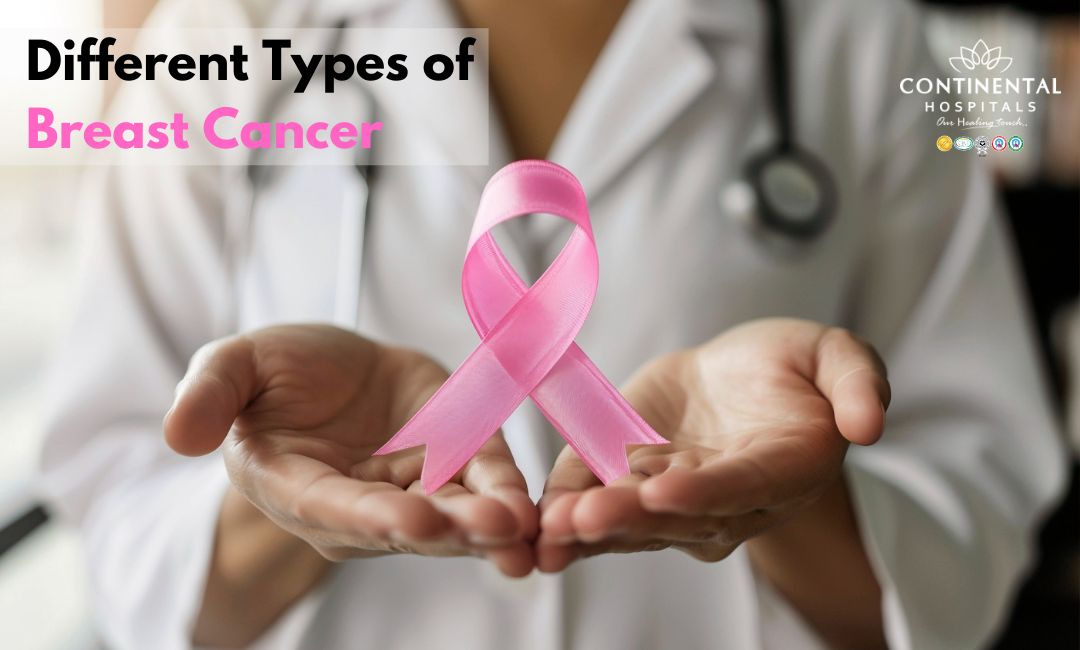Breast cancer is a complex disease with various forms, each requiring different approaches to treatment and management. Understanding these types can be crucial for diagnosis and care. In this blog, we’ll explore the main types of breast cancer, including non-invasive and invasive cancers, luminal A and B, HER2 positive, and basal-like breast cancers.
Different Types of Breast Cancer
Invasive Breast Cancer
Invasive breast cancer means that the cancer cells have spread beyond the ducts or lobules into the surrounding breast tissue. This type of cancer is more aggressive than non-invasive forms and requires more comprehensive treatment.
Invasive Ductal Carcinoma (IDC): IDC is the most common type of breast cancer, making up about 80% of all cases. It starts in the ducts and invades surrounding tissue. IDC can spread to other parts of the body if not treated.
Invasive Lobular Carcinoma (ILC): ILC begins in the lobules and spreads to nearby tissues. It’s less common than IDC and can be more challenging to detect due to its growth pattern, which can make it less noticeable on mammograms.
🥗 Healthy Plate Challenge
🍽 Add Your Favorite Dish
Pick Your 6 favorite foods, eat, and see the results.Drag & drop foods onto your plate.
Drop Food Here
Non-Invasive Breast Cancer
Non-invasive breast cancer means that the cancer cells are contained within the ducts or lobules of the breast and have not spread to surrounding tissues. This type is often referred to as “in situ” cancer. The most common form is Ductal Carcinoma In Situ (DCIS).
Ductal Carcinoma In Situ (DCIS): DCIS is a type of breast cancer where abnormal cells are found in the lining of the breast ducts but haven’t spread beyond them. It’s considered a pre-cancerous stage and is highly treatable with surgery and radiation.
Lobular Carcinoma In Situ (LCIS): LCIS occurs in the lobules of the breast, which are the glands that produce milk. While it is not a true breast cancer, it indicates an increased risk of developing breast cancer in the future.
Luminal A and Luminal B Breast Cancer
Luminal A
Luminal A breast cancer is a subtype that is usually estrogen receptor-positive (ER+) and progesterone receptor-positive (PR+). It tends to grow slowly and has a better prognosis compared to other types of breast cancer.
Characteristics: Luminal A cancers often have low levels of HER2 protein and a lower grade, meaning the cancer cells look more like normal cells. They are often treated with hormone therapy to block the effects of estrogen on cancer growth.
Prognosis: The prognosis for Luminal A breast cancer is generally favorable, with high survival rates and good responses to hormone therapy. It’s often managed with a combination of surgery, hormone therapy, and sometimes radiation.
Luminal B
Luminal B breast cancer is also estrogen receptor-positive but may have higher levels of HER2 or a higher grade compared to Luminal A.
Characteristics: This type can be either HER2 positive or HER2 negative and is generally more aggressive than Luminal A. Luminal B cancers often grow faster and may require more intensive treatment, including chemotherapy in addition to hormone therapy.
Prognosis: The prognosis for Luminal B breast cancer can vary depending on HER2 status and grade. Treatment often involves a combination of surgery, chemotherapy, hormone therapy, and targeted therapies if HER2 positive.
HER2 Positive Breast Cancer
HER2 positive breast cancer has an overexpression of the HER2 protein on the surface of the cancer cells. HER2 stands for Human Epidermal growth factor Receptor 2, which helps regulate cell growth. When this protein is overexpressed, it can cause the cancer cells to grow and divide more rapidly.
Characteristics: HER2 positive cancers are often more aggressive and can grow faster than HER2 negative cancers. They may be diagnosed at a later stage and have a higher chance of spreading to other parts of the body.
Treatment: HER2 positive breast cancer is treated with targeted therapies that specifically attack the HER2 protein, such as trastuzumab (Herceptin) and other similar drugs. Treatment typically includes a combination of surgery, chemotherapy, targeted therapy, and sometimes hormone therapy.
Prognosis: With advances in targeted therapies, the prognosis for HER2 positive breast cancer has improved significantly, and many women with this type of cancer can achieve long-term remission.
Basal-Like Breast Cancer
Basal-like breast cancer is a subtype that typically does not express hormone receptors (ER and PR) or HER2. It’s often referred to as triple-negative breast cancer (TNBC) because it lacks these three common receptors.
Characteristics: Basal-like cancers are usually more aggressive and have a higher likelihood of spreading to other parts of the body. They can be more challenging to treat due to their lack of hormone receptors and HER2 status, which limits the options for targeted therapies.
Treatment: Treatment for basal-like breast cancer often includes a combination of surgery, chemotherapy, and radiation. Research into new treatments and targeted therapies for basal-like cancers is ongoing.
Prognosis: The prognosis for basal-like breast cancer can be more variable due to its aggressive nature. However, advancements in research and treatment are improving outcomes for patients with this subtype.
Conclusion
Understanding the different types of breast cancer is essential for effective diagnosis and treatment. Non-invasive cancers like DCIS and LCIS are typically more manageable, while invasive types such as IDC and ILC require more aggressive treatments. Luminal A and B subtypes vary in their hormone receptor status and treatment approaches, and HER2 positive and basal-like cancers present unique challenges and treatment options.
If you have concerns about your breast cancer risk, it's best to consult with a breast cancer specialist who can assess your individual risk factors
Related Blog Articles:
.webp)














